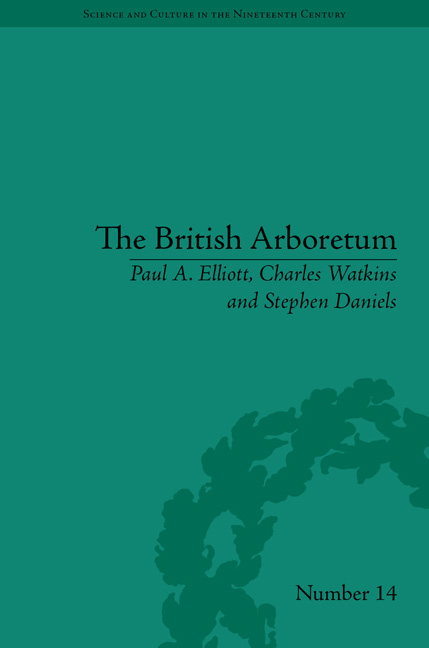Book contents
- Frontmatter
- CONTENTS
- List of Figures
- Preface
- Introduction
- 1 British Tree Cultures in the Nineteenth Century
- 2 Trees and Taxonomy
- 3 British Arboriculture, c. 1800–35
- 4 John Claudius Loudon's Arboretums
- 5 The Botany of the Arboretum Britannicum
- 6 The Derby Arboretum
- 7 Estate Arboretums
- 8 Public Urban Arboretums
- 9 The Transformation of Victorian Public Arboretums
- Conclusion
- Notes
- Works Cited
- Index
6 - The Derby Arboretum
- Frontmatter
- CONTENTS
- List of Figures
- Preface
- Introduction
- 1 British Tree Cultures in the Nineteenth Century
- 2 Trees and Taxonomy
- 3 British Arboriculture, c. 1800–35
- 4 John Claudius Loudon's Arboretums
- 5 The Botany of the Arboretum Britannicum
- 6 The Derby Arboretum
- 7 Estate Arboretums
- 8 Public Urban Arboretums
- 9 The Transformation of Victorian Public Arboretums
- Conclusion
- Notes
- Works Cited
- Index
Summary
Introduction
The popularity of botanical gardens and private tree collections during the 1820s and 1830s helps to explain why the latter played an important role in the provision of Victorian public parks providing both a general model and an inspiration for more varied planting schemes. Instructed by the donor, the industrialist Joseph Strutt (1766–1844), Loudon intended the Derby Arboretum to promote his vision of public arboretums and provide a living spatial realization of the Arboretum Britannicum (1838) and the Candollean natural system. In so doing they created one of the first specially designed Victorian public parks. But there were tensions between the need to preserve a botanically-significant tree collection and the demands of public access mirroring those experienced by botanical society gardens, which impacted upon the management of all public arboretums. However, for about thirty years the Derby Arboretum management committee was able to reconcile these demands whilst regularly holding some of the largest festivals in the region. The Derby Arboretum also demonstrates the importance of provincial scientific culture and rational recreation, and provides an example of how local initiatives in provincial towns, as well as government legislation, fostered Victorian municipal innovation. It was supported by a local group of scientific activists known as the Derby philosophers because of their association with the Derby Philosophical Society and other scientific institutions. In encouraging the foundation of other public parks and arboretums, the Derby Arboretum helped to set the pattern for Victorian public urban parks, although it remained only a semi-public institution.
- Type
- Chapter
- Information
- The British ArboretumTrees, Science and Culture in the Nineteenth Century, pp. 135 - 154Publisher: Pickering & ChattoFirst published in: 2014



